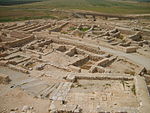Tel Sheva
1967 establishments in IsraelArab localities in IsraelBedouin localities in IsraelLocal councils in Southern District (Israel)Populated places established in 1967 ... and 1 more
Populated places in Southern District (Israel)

Tel Sheva (Hebrew: תֵּל שֶׁבַע) or Tel as-Sabi (Arabic: تل السبع) is a Bedouin town in the Southern District of Israel, bordering the city of Beersheba. In 2021 it had a population of 22,187.
Excerpt from the Wikipedia article Tel Sheva (License: CC BY-SA 3.0, Authors, Images).Tel Sheva
Ibn Rushad,
Geographical coordinates (GPS) Address Nearby Places Show on map
Geographical coordinates (GPS)
| Latitude | Longitude |
|---|---|
| N 31.246666666667 ° | E 34.856111111111 ° |
Address
clalet
Ibn Rushad
South District, Israel
Open on Google Maps










